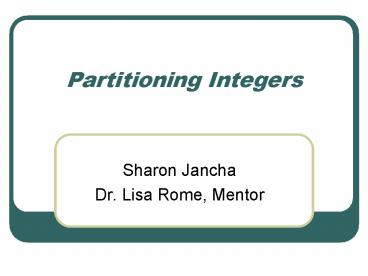Partitioning Integers PowerPoint PPT Presentation
1 / 37
Title: Partitioning Integers
1
Partitioning Integers
- Sharon Jancha
- Dr. Lisa Rome, Mentor
2
Math Problem
- Total 7 crayons
- Some are red
- Some are blue
- How many of each could you have?
43
25
61
3
Math Problem
- Total 7 crayons
- How many of each color if
- Three colors?
- Four colors?
- Seven colors?
- How many ways can we have 7 crayons using at most
7 colors?
322
3211
1 of each color
4
S. Ramanujan
- From India
- Born Dec 22, 1887
- Died Apr 26, 1920
- Mostly self taught
- 30 publications since his death
5
Ramanujan and Hardy
- 1913 1919
- Partitions
- Approximating formula
6
Definition
- Partition function, p(n), is the number of ways
to write the integer n as a sum of non-negative
integers less than or equal to n.
7
Examples
8
Example p(5)
- 5
- 41
- 32
- 311
- 221
- 2111
- 11111
p(5) 7
221
9
Visual RepresentationsRectangular Blocks
- 5
- 41
- 32
- 311
- 221
- 2111
- 11111
10
- Leading Part is a1
11
Example p(5)
- 5
- 41
- 32
- 311
- 221
- 2111
- 11111
- 5
- 41
- 32
- 311
- 221
- 2111
- 11111
- 5
- 41
- 32
- 311
- 221
- 2111
- 11111
- 5
- 41
- 32
- 311
- 221
- 2111
- 11111
- 5
- 41
- 32
- 311
- 221
- 2111
- 11111
12
Partitions sub m
- The number of partitions of an integer n with no
part bigger than m. - Written as pm(n)
13
Example p3(5)
- 5
- 41
- 32
- 311
- 221
- 2111
- 11111
p3(5) 5
14
Differences in pm(5)
1
1 2 2 1 1 7 p(5)
15
Differences in pm(4)
1 2 1 1 5 p(4)
16
Differences in pm(3)
1 1 1 3 p(3)
17
Differences in pm(2)
1 1 2 p(2)
18
Differences in pm(1)
1 p(1)
19
Triangle
p(5) 7
1 2 2 1 1 7
20
Triangle
p3(5) 5
1 2 2 1 1 5
21
- R row number
- E element number in row
R 4 E 3
1
22
Build 7th Row
- 2 simple steps
- Which previous row
- Sum the correct elements
23
Row 7 1st element
- Find R E
- 7 - 1 6
- Add the first E elements
- E 1
1
24
Why 1?
- Element Number Leading part
E 1
25
Row 7 2nd element
- R 7 and E 2
- R E 7 2 5
- Add first E terms
3
26
Why 3?
- Element Number Leading part
E 2
27
Row 7 3rd element
- 7 3 4
- Add first 3 terms
4
28
Row 7 4th element
- 7 4 3
- Add first 4
- terms
3
29
Row 7 5th element
- 7 5 2
- Add first 5
- terms
2
30
Row 7 6th element
- 7 6 1
- Add first 6
- terms
1
31
Row 7 7th element
- 7 7 0
1
32
Why 1?
- Element Number Leading part
E 7
33
p(7) ?
34
p(7)
How many ways can 7 crayons be divided into at
most 7 colors?
15
35
Further areas of study
- Drawn p(1) through p(20)
- Distinct verses non-distinct partitions
- Odd and Even partitions
- Extended triangle
- Proving patterns within
36
Thank you to
- My family and friends
- Dr. Rome, and Prof. Dunlap
- Faculty, and Staff
37
Questions?

